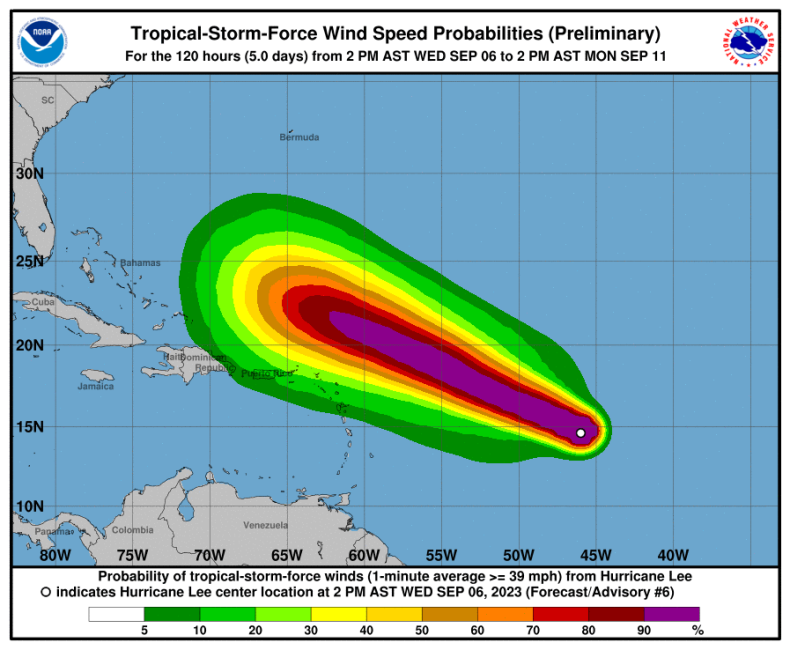Tropical Storm Lee has strengthened into a hurricane and is forecast to become “extremely dangerous” by the weekend, possibly even intensifying into a Category 4, experts warn.
Lee was upgraded to a Category 1 hurricane on Wednesday, according to a 5 p.m. ET update by the National Hurricane Center (NHC), which predicts the storm will become a “major hurricane” by early Saturday.
As of Wednesday evening, the hurricane had wind speeds topping 75 mph and was continuing to gain momentum, Kelly Godsey, a senior service hydrologist and meteorologist with the National Weather Service (NWS) in Tallahassee, Florida, told Newsweek in a phone interview on Wednesday night.
National Hurricane Center
“Extremely favorable” conditions, such as warm ocean water and light wind shear, are helping Lee strengthen rapidly, he said.
“Storms like these, they can intensify very quickly,” Godsey told Newsweek. “Lee is forecast to become a major hurricane by Friday. Amazingly, a Category 4 hurricane by Saturday. That’s going to be the time that it is nearing the Leeward Islands and the U.S. Virgin Islands. Then Lee will near Puerto Rico by Sunday.”
Hurricane Lee is moving northwest through the Caribbean Sea at roughly 14 mph, the NHC said.
Godsey said it’s still too early to forecast whether Lee will make landfall, but he said even if the hurricane remains offshore, it still has potential to bring life-threatening weather conditions.
“Anytime you take a storm like this and you bring it near a landmass, it’s going to generate very dangerous surf and life-threatening rip currents as well,” he said. “So even if this storm stays well offshore of the Leeward Islands and Puerto Rico, there are still hazards that residents on those islands need to be aware of as the storm approaches and moves past.”
At the moment, there are no coastal watches or warnings in effect, the NHC said, noting that the Leeward Islands should monitor the storm. Godsey warns that this could change, urging residents in the storm’s projected path to “monitor Lee closely.”
Swells generated by Hurricane Lee are expected to reach portions of the Lesser Antilles on Friday, and the British and U.S. Virgin Islands and Puerto Rico by the weekend. These huge waves are likely to cause “life-threatening surf and rip current conditions,” NHC said.
Godsey told Newsweek that even if the storm doesn’t near Florida or mainland U.S., some of the severe weather conditions could reach coastal communities.
“It’s almost like when you drop a rock in a pond, the ripples go out in all directions,” he said. “As Lee continues to move on to the northwest and get closer toward Florida, the swells or the waves from the storm are going to move toward the east coast of Florida, and the East Coast of the United States, and those waves are going to generate very dangerous or life-threatening currents.”
He warns that those hazardous beach conditions could be expected as soon as early next week.
“Even if Lee gets nowhere near the east coast of Florida, we’re still going to have those beach conditions that are going to be hazardous for folks.”

National Hurricane Center
Godsey said Lee is expected to be a hurricane for some time, well into next week. He said if Lee does intensify into a Category 4, it could bring winds topping 130 mph.
Tropical storm-force winds, which can reach up to 73 mph, are forecast to hit Puerto Rico, the Dominican Republic, Haiti and the Leeward Islands.
“This is an excellent time for everyone to just review their hurricane plan,” Godsey told Newsweek. “The peak of hurricane season is September 10 and here we are on September 6 talking about what will be a major hurricane. So it’s an excellent time all up and down the East Coast of the United States to recheck your family’s preparedness plan and know what you might do if a storm was approaching your community.”


